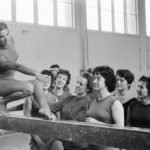Is Gymnastics a Sport? You bet it is, and we’re about to debunk all the doubts! Dive into our guide where we flip through the misconceptions and stick the landing on why gymnastics is not just a sport, but an extraordinary display of athleticism and artistry.

Gymnastics requires strength, speed, flexibility, and mental fortitude, making it a challenging and demanding discipline. With some of the highest viewing figures at the Olympic Games, gymnastics has proven to be a popular and exciting competition.
Gymnastics is often met with a wave of criticism and debate surrounding whether or not it is truly a sport. The argument stems from the use of judges and the difficulty values involved in scoring competitions.
However, gymnastics meets all the criteria of a sport according to the definition: “An activity involving physical exertion and skill in which an individual or team competes against another or others for entertainment.”
In this article, we will explore the reasons why some people argue against gymnastics being a sport, the competitive aspect of gymnastics, the level of difficulty involved in gymnastics, and the history of this ancient discipline.
Why do people think gymnastics is not a real sport?
Judging is one of the biggest sources of controversy when it comes to the legitimacy of gymnastics as a sport. Critics argue that the results of competitions are solely based on judges’ opinions.
However, this is not unique to gymnastics as other sports such as figure skating, fencing, and diving also rely on judges.
These other judging-based sports also feature in the Olympic games.
- Figure Skating
- Trampoline
- Boxing
Gymnastics Competitions
Gymnasts compete against each other by performing routines or specific skills which are then judged and given a score.
A competitive gymnast will spend their younger years preparing their body to cope with these types of fitness physically. This will allow them to improve their agility, balance, and coordination and ultimately acquire skills such as rolling, jumping, hanging and swinging.
The use of judges is essential in competitive gymnastics. A judge’s job is to use a set standard (code of points) and decide which things a gymnast has done well in a routine. This is known as the execution score. There is an element of human error but judges are usually well-trained and often have senior judges overseeing the marking process.
Usually, each specific skill that a gymnast performs will have a difficulty value attached to it. The harder the skill, the higher the value. A set judge will record which skills are performed and then add the overall difficulty to the execution score to give an overall score.
Different types of gymnastics will have their own agreed scoring rules, but most will work similarly.
The Federation of International Gymnastics (FIG) is responsible for publishing the code of points for each discipline in gymnastics but each continent and individual country will have additional rules and codes they use.
How Hard is Gymnastics?
Gymnastics is considered one of the hardest sports in the world in terms of reaching an elite level because it requires a high level of all-around physical ability. This is especially true of artistic gymnastics which involves four apparatus for women or six for men.
Some demand immense upper body strength such as the Rings (men) whilst something like tumbling on the floor requires a lot of leg power.
Because of the wide range of demands, elite gymnasts spend up to 40 hours a week training all of the individual elements needed to become great all-around gymnasts.
The table below shows the average number of training hours per week for elite competitors in different sports.
| Sport | Number of Training Hours |
| Gymnastics | 35 |
| Athletics | 20-30 |
| American Football | 20-25 |
| Soccer | 20 |
| Swimming | 20 |
| Boxing | 15-20 |
As you can see, elite gymnasts train significantly longer than many other sports. 40 hours per week is the equivalent of a full-time job and generally speaking for very little money. It also starts from a young age in comparison to other sports because of the younger peak age and early retirement ages.
There is also a huge risk factor when performing high-level skills. A Trampoline gymnast will perform multiple twisting somersaults one after the other knowing that one minor slip could mean landing on their neck and a serious injury.
Is Gymnastics harder than Football? Read my full article here.
Having said all that, gymnastics is still a great sport for beginners of all ages and abilities. Recreational gymnastics should be fun and is a great way to keep fit – it doesn’t have to be extremely hard unless you want to be an elite competitor.
Gymnastics Disciplines and Events
There are eight FIG-recognized competitive disciplines:
- Women’s Artistic
- Men’s Artistic
- Rhythmic
- Trampoline
- Tumbling
- Acrobatic Gymnastics
- Aerobic Gymnastics
- Parkour
Team Gym is recognized in Europe by the UEG but is not currently a FIG discipline.
Recreational gymnastics (also known as Gymnastics for All) often combines parts of multiple disciplines as it is about participation and enjoyment rather than winning competitions.
Disciplines vary because of the apparatus and equipment that is used. Some are found in multiple disciplines, whilst others are unique. Women’s Artistic involves floor, vault, beam and uneven bars. Men’s Artistic also uses Floor and Vault plus Rings, Parallel Bars, Pommel Horse and High Bars.
Rhythmic gymnastics is performed on a floor area similar to both Women’s and Men’s Artistic, but gymnasts do less tumbling and focus more on dance and flexibility skills. They also use hand apparatus such as hoops, balls and ribbons which are not used in any other competitive discipline.
Acrobatic gymnastics involves balancing in pairs or groups with each other. For example, a gymnast at the top could hold a one-arm handstand on the head of a base gymnast. It really is breathtaking to watch!
A Quick History of Gymnastics
The origins of gymnastics can be traced back to Ancient Greece.
Gymnastics in Ancient Greece
Philostratus the Greek teacher (or sophist) documented exercise of the time as ‘gymnazo’ which translates to ‘exercise naked’.
At the time, physical attributes such as strength and speed were considered highly desirable. By developing early gymnastics training, the ancient Greeks were able to improve people’s all-around fitness.
Gymnastics in the Roman Empire
The Romans later developed the same principles into more formal sporting events and also for training soldiers and preparing them physically for warfare. However, as the Roman empire shrank, so did the popularity of gymnastics-type exercises.
During the Middle Ages, there is still evidence of tumbling-type skills being performed as entertainment by Court Jesters for the noblemen and women of the time.

Friedrich Ludwig Jan
It wasn’t until 1811 that the origins of modern gymnastics can be really traced. Friedrich Ludwig Jan, a Prussian educator, is credited with inventing the horizontal bar, parallel bars and balance beams and more apparatus that we are familiar with today. He opened an open-air gymnasium called a ‘Turnplatz’ in 1811 in a bid to improve the physical attributes and morale of his countrymen following an embarrassing defeat by Napolean.
Gymnastics in the USA
European immigrants are credited with introducing gymnastics to the USA. This includes Germans Charles Beck who opened the first gymnasium in the US in Massachusetts in 1825 and Charles Follen who opened the first college gymnasium at Harvard in 1826. Follen also opened the first public gymnasium in the US in Boston in 1826.
FIG Founding
The Federation of International Gymnastics (FIG) is the world governing body for Gymnastics and was founded in 1881 in Liege, France. Its continued popularity meant that gymnastics was included in the first modern Olympics in Athens, Greece in 1896.
Since then the sport has modernized and adapted to the sport we know today.
During the 1960s and 70s, the Soviet Union made great advances in training methods and skill levels which other countries, especially in the Eastern Bloc replicated.
This led to many notable female gymnasts emerging such as Olga Korbut (USSR) and Nadia Comaneci (Romania).
Gymnastics in the Olympics
Out of the eight recognized disciplines, only four are included in the Olympics:
- Men’s Artistic (since 1896)
- Women’s Artistic (since 1936)
- Rhythmic (since 1984)
- Trampoline (since 2000)
Non-Olympic disciplines
Other disciplines will have world championships or pan-continental championships such as Europeans. The World Games is another top event for non-Olympic disciplines and includes Tumbling, Sports Acrobatics and Sports Aerobics but not the four disciplines that are included in the Olympics.
Other Sports Like Gymnastics
Because gymnastics involves a wide range of movements and coordination, there are lots of links to other sports. For example, gymnasts have to be able to run, jump, balance, land and dance. Most other sports in the world will use at least one of these types of movements. However, in my opinion, the closest sports to gymnastics are:
- Dance (of all types)
- Diving
- Cheerleading (yes it’s a real sport too!)
- Figure Skating
- Martial Arts
- Skiing
Final Verdict
In conclusion, gymnastics is definitely a sport. It involves physical exertion and skill and can be performed on an individual or team basis. Despite the reservations, some people have around judges scoring, generally, competitions are scored fairly and accurately. Whether you are a gymnast or simply a fan, gymnastics is a truly spectacular sport worth watching and appreciating.
FAQs
Is Gymnastics a Sport yes or no?
Gymnastics is a sport that requires athleticism, flexibility and hard work. However, some argue that its reliance on gymnastics judges subjective opinions for scoring undermines its position as a real sport.
What sport goes with gymnastics?
There are plenty of sports that go well with gymnastics including Cheerleading, Dance, Figure Skating, Skiing and Parkour.
What do you call a gymnastics person?
People who take part in gymnastics are called gymnasts.
Can gymnastics be a team sport?
Yes, gymnastics can be a team sport in the sense that some competitions combine gymnasts’ scores to determine the overall winner. This is true of international gymnastics like the Olympics or College Gymnastics. There is also a specific discipline called Team Gym which combines group Floor Routines, Tumbling and Trampette.
Why do people say gymnastics is not a sport?
Some people say gymnastics is not a sport because judges have to decide who the winners and losers are at competitions.
- A Complete Guide to Gymnastics Hand Rips
 Are you tired of dealing with painful gymnastics rips on your hands from training? Look no further – this article offers a comprehensive approach to… Read more: A Complete Guide to Gymnastics Hand Rips
Are you tired of dealing with painful gymnastics rips on your hands from training? Look no further – this article offers a comprehensive approach to… Read more: A Complete Guide to Gymnastics Hand Rips - Is Gymnastics Dangerous? (Facts and Comparisons)
 Gymnastics is acknowledged as a highly technical and physically demanding sport. It inherently carries a risk of injury, which is why most coaches and clubs… Read more: Is Gymnastics Dangerous? (Facts and Comparisons)
Gymnastics is acknowledged as a highly technical and physically demanding sport. It inherently carries a risk of injury, which is why most coaches and clubs… Read more: Is Gymnastics Dangerous? (Facts and Comparisons) - The Fascinating Evolution of Gymnastics (History and Facts)
 Gymnastics is a sport that has been around for centuries and has evolved significantly throughout history. From its origins in ancient Greece to the modern-day… Read more: The Fascinating Evolution of Gymnastics (History and Facts)
Gymnastics is a sport that has been around for centuries and has evolved significantly throughout history. From its origins in ancient Greece to the modern-day… Read more: The Fascinating Evolution of Gymnastics (History and Facts) - The Ultimate Parallel Bars Skills List
 Parallel bars are one of the most challenging events in men’s gymnastics. Mastering the right moves first on parallel bars is essential to improving your… Read more: The Ultimate Parallel Bars Skills List
Parallel bars are one of the most challenging events in men’s gymnastics. Mastering the right moves first on parallel bars is essential to improving your… Read more: The Ultimate Parallel Bars Skills List - The Long-Term Effects of Gymnastics on the Body (A Complete Guide)
 While gymnastics can offer many benefits, such as improved fitness and self-confidence, many people also ask what are the Long-Term Effects of Gymnastics on the… Read more: The Long-Term Effects of Gymnastics on the Body (A Complete Guide)
While gymnastics can offer many benefits, such as improved fitness and self-confidence, many people also ask what are the Long-Term Effects of Gymnastics on the… Read more: The Long-Term Effects of Gymnastics on the Body (A Complete Guide) - What Age Does Competitive Gymnastics Start?
 Ever wondered what age does competitive gymnastics start? It’s well known that gymnasts start training at a young age to develop the skills and strength… Read more: What Age Does Competitive Gymnastics Start?
Ever wondered what age does competitive gymnastics start? It’s well known that gymnasts start training at a young age to develop the skills and strength… Read more: What Age Does Competitive Gymnastics Start?
